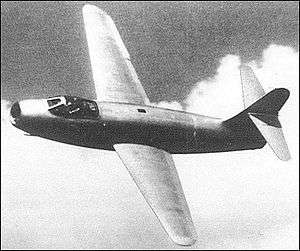Yakovlev Yak-19
| Yak-19 | |
|---|---|
 | |
| A Yak-19 in flight | |
| Role | Fighter aircraft |
| Manufacturer | Yakovlev |
| First flight | 8 January 1947 |
| Status | Prototypes |
| Number built | 2 |
|
| |
The Yakovlev Yak-19 was a prototype Soviet fighter aircraft built in 1947. It was the second Yakovlev jet fighter after the Yak-15, and the first OKB aircraft designed from the onset to have an all-metal stressed skin, and a hydraulic system. The Yak-19 was the second Soviet aircraft to use an afterburning turbojet, the Klimov RD-10F, and the last Yakovlev Aircraft to use a version of the German Jumo 004-derived RD-10 jet engine. Only two examples were built. The USAF/DoD reporting name - "Type 7".[1]
Design and development
In the spring of 1946 OKB-115 set about designing the Yak-19. The aircraft was to have midset, all-metal, straight wings and levered-suspension tricycle undercarriage, which would become the basis for future Fighter development in the USSR.
The design of the Yak-19 was a radical departure from the "step" layout of the earlier Yak-15 and Yak-17.
All tail surfaces were of metal construction, though only the elevators had tabs.
The tricycle landing gear was pneumatically operated, and had three nitrogen/oleo struts. The nosewheel was castoring, and retracted forward behind the engine ducts, faired by two doors. Fuel capacity was 815 liters (179.3 gallons) in two fuselage tanks, plus an additional 11 liters stored in the starter engine to assist ignition of the afterburner, which was fueled by a separate electrically-driven pump.
The cockpit had a bulletproof windscreen. A RSIU-6 radio was standard. Armament consisted of two Nudelman-Suranov NS-23 cannon, with 70-75 rounds each.
Testing
Two prototypes were built. Each remained unpainted. They were found to be only slightly heavier than the earlier Yak-15 and Yak-17. The first prototype, (Yak-19-I), had the call sign "Yellow 24", and a number "5" on the lower rudder. It first flew on the 8 January 1947 with test pilot M I Ivanov at the controls. In flight the aircraft was found to have pleasant and predictable characteristics. Its worst aspect was the afterburner, which slightly lowered the aircraft's dry thrust. Worse yet, it was ignited by a complicated and totally unreliable procedure which would have been useless in combat. This prototype was later modified with a square-tipped rudder.
The second prototype (Yak-19-II), had the call sign "Yellow 25", and the number "2" on the lower rudder. It was seen at the 3 August 1947 Tushino flypast. Differing in minor details, the Yak-19-II had a four degree dihedral on the horizontal stabiliser and underslung tip tanks, as on the Yak-17.
S. N. Anokhin was the test pilot during the NII-VVS testing, which was completed on 21 August 1947. He agreed that the aircraft possessed good handling qualities, but felt that the engine was outdated, weak and unreliable.
After failing State acceptance tests (for reasons including high stick forces, no heating or ventilation, and inadequate armour), further development was abandoned. The death knell of the Yak-19 was also sounded by the arrival of the Rolls-Royce Derwent-derived Klimov RD-500, which gave quantum leaps forward in thrust, reliability, longevity, and ease of maintenance.
No ASCC reporting name was ever allotted, as the aircraft remained unknown to the west until the late 1970s.
The aircraft was known though after the appearance at the annual Tushino Flypast, but under another name. It was represented in an early 1950s book, "Russias jets and other aircraft" as the Lavochkin La-15, while in the same book the real La-15 was presented as the La-17. There is a blurred picture and an incorrect drawing of the first prototype, with no diheral on the tailplanes.[2]
Variants
- Yak-19-I
- First prototype.
- Yak-19-II
- Second prototype with some improvements.
Specifications (Yak-19)

General characteristics
- Crew: one
- Length: 8.36 m (27 ft 5 in)
- Wingspan: 8.70 m (28 ft 7 in)
- Height: ()
- Wing area: 13.56 m² (145.96 ft²)
- Empty weight: 2,192 kg (4,832 lb)
- Loaded weight: 3,050 kg (6,724 lb)
- Max. takeoff weight: 3400kg ((7495lb))
- Powerplant: 1 × Klimov RD-10F turbojet, 10.7 kN (2,405 lbf)
Performance
- Maximum speed: 907 km/h at 5,250 m, 875 km/h at sea level (490 knots, 563 mph at 17,225 ft; 472 knots, 543 mph at sea level)
- Range: 550 km (340 miles)
- Ferry range: 895 km with drop tanks (555 miles)
- Service ceiling: 12,100 m (39,700 ft)
- Rate of climb: 20.8 m/s (4,094 ft/min)
- Wing loading: 226kg/m² ((46.33lb/ft²))
- Thrust/weight: 0.365
Armament
- 2x Nudelman-Suranov NS-23 cannon, 150 rounds each
See also
- Related development
- Aircraft of comparable role, configuration and era
- Related lists
Notes
- ↑ http://www.designation-systems.net/non-us/soviet.html#_DOD_Type
- ↑ "Russias jets and other aircraft", Smith & Hallam Ltd.
Bibliography
- Gordon, Yefim; Komissariov, Dmitry and Sergey (2005). OKB Yakovlev: A History of the Design Bureau and its Aircraft. Hinckley, England: Midland Publishing. ISBN 1-85780-203-9.
- Gunston, Bill (1995). The Osprey Encyclopedia of Russian Aircraft 1875-1995. London: Osprey. ISBN 1-85532-405-9.
- Gunston, Bill. Yakovlev Aircraft since 1924. London, UK: Putnam Aeronautical Books, 1997. ISBN 1-55750-978-6.
External links
| Wikimedia Commons has media related to Yakovlev aircraft. |
The initial version of this article was based on material from aviation.ru. It has been released under the GFDL by the copyright holder.